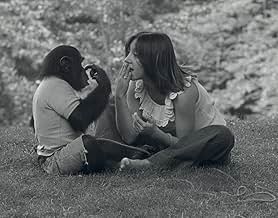Füge eine Handlung in deiner Sprache hinzuTells the story of a chimpanzee taken from its mother at birth and raised like a human child by a family in a brownstone on the upper West Side in the 1970s.Tells the story of a chimpanzee taken from its mother at birth and raised like a human child by a family in a brownstone on the upper West Side in the 1970s.Tells the story of a chimpanzee taken from its mother at birth and raised like a human child by a family in a brownstone on the upper West Side in the 1970s.
- Nominiert für 1 BAFTA Award
- 16 Gewinne & 30 Nominierungen insgesamt
- Self
- (Archivfilmmaterial)
- Self
- (Archivfilmmaterial)
- Self
- (as Dr. James Mahoney)
- Self
- (Archivfilmmaterial)
Empfohlene Bewertungen
What instead results is indeed a spectacle to witness. Nim is indeed a remarkable chimp who was sadly the victim of human inexperience with supplying the type of care he needed and deserved. What we learn is not what a chimpanzee is lacking, but what humanity is.
I suggest watching the film with a mind towards what Nim himself must be thinking as you see his life unfold. Nim lives a chimpanzee's analog to a human life, but for a chimp, it is utterly horrifying to watch. But like any life, there are more lighthearted moments as well, such as Nim and his friend Bob with their "Stone." "Smoke." "Now." time together, which actually seemed to be Nim's best time with any humans.
All in all, this documentary of Nim's life serves as a reminder that mother nature made chimpanzees and humans their own devices for communicating and living separately. The two cannot co-exist peacefully within one habitat due to the gap in strength and cognitive intelligence. However this one chimp, Nim, came remarkably close to peaceful co-habitation and viable communication with humans and his cost for such was great.
Sure it has a fascinating subject in the chimp Nim, but the more fascinating subjects are the humans who inhabit his life. From the professor who never saw Nim as any more than a subject. To the family who yearn to reconnect with him. And finally people who would rescue him from isolation. The camera really turns away from the animal back to all of us as a species.
The movie is more about a team of people trying to salvage and place an off the track train back on it, when the damage was already done.
Firstly, I do agree with the other reviewers comments on futility, I do not, however, agree entirely with Professor Terrace's view that the project was a failure, though conversely I do think the project failed Nim. To expand on this I would say that the conclusion of Terrace's failure seemed to fit a classic narrow set of parameters by which you compare and judge the outcome solely on an initial and highly specific expectation of what you will achieve. To this end perhaps it failed Professor Terrace's criteria.
I think however opportunities were certainly lost. Nim seemed to interact in so many subtle and fascinating ways during the process of his teaching, and he seemed to teach a great deal to all of the assistants who gave him their care. There seemed to be so little structure from the start with regards to what was to be taught and observed and in which direction the project should be going.
The only constant seemed to be the teaching of signing, at which Nim excelled! From what I could see, regardless of whether he learnt the actions to manipulate his handlers or not, he still learnt the signs. Since it was known that the chimp could not form human speech, how was it to communicate what it had learnt and why it was using the language in this way? I found this point frustrating and dubious and an example of one person with their eye so "firmly on the prize", that they miss the importance of the process.
Importantly, everybody who was involved across the duration of the project was given a chance to clearly state the turn of events. Perspectives on this varied widely, as you would expect, as everybody brought a different set of expectations and sensibilities, but it was a mature approach which I think led to the films balanced handling of Nim's story.
All in all I found it a fascinating cautionary tale. Luckily the balance of academic ego versus humanity that twists through this story left me with hope that indeed something had been learnt from the unique life of this Chimpanzee.
The chimp's name is taken from Noam Chomsky, the famous MIT linguist. Unfortunately, the linguistic side of this story actually is quite minor compared to what really occurred. Columbia professor Herbert Terrace wanted to conduct an experiment on a baby chimp to see if it could be raised like a human baby and learn to communicate with people. He started the project by snatching the baby from its mother at two weeks of age, and then plopping it right into a large, free-spirited family with no scientific or primate-training background. Heck, no one in the family even knows sign language! The film shows how quickly Nim adapts to the pampered lifestyle and is even breast-fed by Stephanie, the mother. Nim is also exposed to smoking pot, drinking alcohol and even has limited success being potty trained. All of this is explained away with "it was the seventies". I was already bouncing between sadness and anger.
Admittedly, I am no scientist. I do know that a true science experiment or project would involve specific records and at least some type of plan ... not to mention the recording of actions, tests and progress. Instead, Professor Terrace shows up periodically for some photo ops and a hug from Nim. Poof! He is gone again. While this is never really explained in the film, one can only assume he was benefiting nicely from a huge grant, not to mention "close" relationships with a couple of his assistants. The other thing left unexplained was how Nim's mother had other babies taken from her in a similar manner. We get no detail on those "experiments".
As Nim gets older, guess what ... he gets bigger and stronger. He is difficult to control and even lashes out periodically at his caregivers, once quite violently. He is bounced from home to home and person to person. He does adapt, but he is just too strong and unpredictable to be part of human society. Finally, he is sold off to an animal rescue farm. That's just great, except initially there are no other chimps. Not a good thing for a social primate.
The whole thing is just painful to watch. I couldn't help but feel sympathy for the chimp and anger at the people ... especially Professor Terrace. His selfish, ill-conceived project negatively impacted the life of a chimp and the safety and well-being of many good-hearted people along the way.
While there was proof that Nim learned approximately 125 signs, the question remains ... did he really understand these words and phrases? Did he instead learn behavior that led to his reward? One of Nim's later day caregivers (Bob Ingersoll) visited him often at the rescue farm until at the age of 26, Nim passed away. The average lifespan of a chimp in the wild is about 45 years. So, it would appear neither the chimp or the people really benefited from Project Nim. It is, however, a well made documentary.
Wusstest du schon
- WissenswertesVeteran primate choreographer and actor Peter Elliott actually met and worked with Nim Chimpsky when he was researching chimpanzees for Greystoke - Die Legende von Tarzan, Herr der Affen (1984). He also met and worked with another famous signing chimp by the name of Washoe.
- Zitate
Herbert Terrace: Wouldn't it be exciting to communicate with a chimp and find out what it was thinking? If they could be taught to articulate what they were thinking about, this would be an incredible expansion of human communication, and possibly give us some insight into how language, in fact, did evolve.
- VerbindungenFeatured in Maltin on Movies: Harry Potter and the Deathly Hallows: Part 2 (2011)
- SoundtracksCollide
Written by Autumn Rowe
Top-Auswahl
- How long is Project Nim?Powered by Alexa
Details
- Erscheinungsdatum
- Herkunftsländer
- Offizieller Standort
- Sprache
- Auch bekannt als
- Proyecto Nim
- Drehorte
- Produktionsfirmen
- Weitere beteiligte Unternehmen bei IMDbPro anzeigen
Box Office
- Bruttoertrag in den USA und Kanada
- 411.184 $
- Eröffnungswochenende in den USA und in Kanada
- 25.820 $
- 10. Juli 2011
- Weltweiter Bruttoertrag
- 612.839 $
- Laufzeit1 Stunde 33 Minuten
- Farbe
- Sound-Mix
Zu dieser Seite beitragen




























